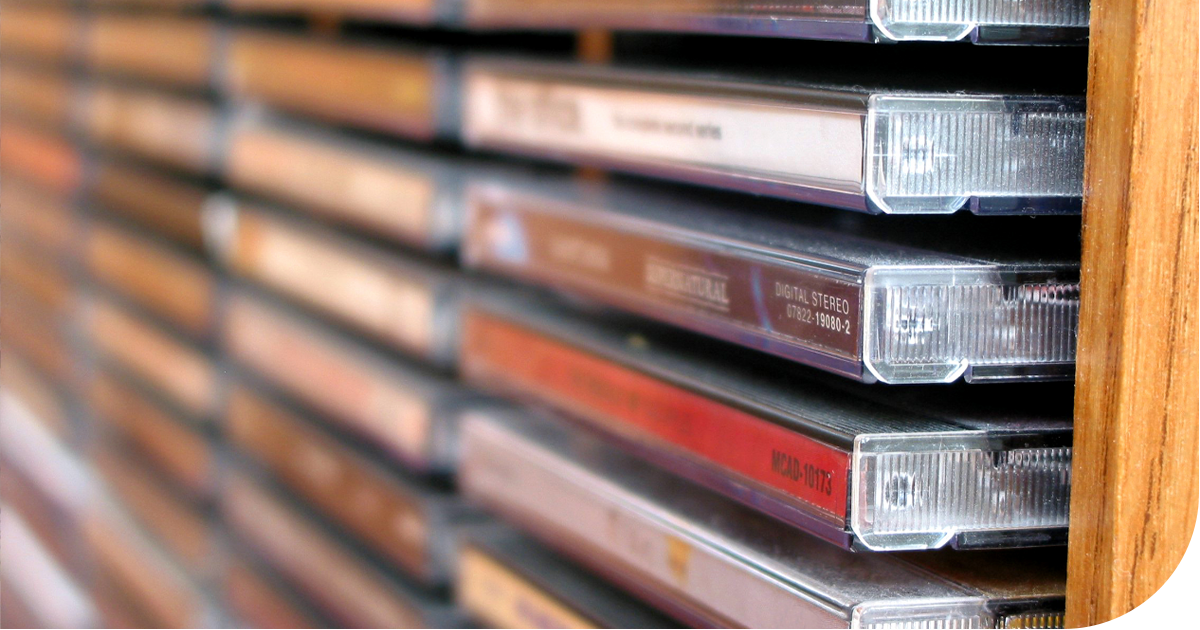Digital audio files and optical discs often work hand in hand. By preserving optical discs, you can protect your digital audio or video files.
Optical Discs
Deterioration of optical discs is often the result of manufacturing defects. However, preserving these items properly can extend their lifespan. Most damage is caused by careless handling, mechanical problems, and environmental exposure. When handling discs, it is important to support the middle and edge of the disc or just the edges. Mechanical problems can cause scratches to the disc – such as a malfunctioning disc reader. Environmental damage can be caused by fluctuations in temperature and humidity. Many people store discs in their vehicles – where the changes in temperature and humidity can be extreme in relatively short periods. For storage, maintain a temperature between 68-39°F with a relative humidity of 20-50%. For long-term storage, keep the temperature around 64°F and 40% RH. Do not store at or below freezing.
DO:
- Handle discs by the outer edge or the center hole
- Use a non-solvent-based felt-tip permanent marker to mark the label side of the disc
- Keep dirt or other foreign matter from the disc
- Store discs upright (book style) in plastic cases specified for CDs and DVDs
- Return discs to storage cases immediately after use
- Leave discs in their packaging (or cases) to minimize the effects of environmental changes
- Open a recordable disc package only when you are ready to record data on that disc
- Store discs in a cool, dry, dark environment in which the air is clean
- Remove dirt, foreign material, fingerprints, smudges, and liquids by wiping with a clean cotton fabric in a straight line from the center of the disc toward the outer edge
- Use CD/DVD-cleaning detergent, isopropyl alcohol, or methanol to remove stubborn dirt or material
- Check the disc surface before recording
DO NOT:
- Touch the surface of the disc
- Bend the disc
- Use adhesive labels
- Store discs horizontally for a long time (years)
- Open a recordable optical disc package if you are not ready to record
- Expose discs to extreme heat or high humidity
- Expose discs to extremely rapid temperature or humidity changes
- Expose recordable discs to prolonged sunlight or other sources of ultraviolet light
- Write or mark in the data area of the disc (the area the laser "reads")
- Clean by wiping in a direction going around the disc
For CDs especially do not:
- Scratch the label side of the disc
- Use a pen, pencil, or fine-tip marker to write on the disc
- Write on the disc with markers that contain solvents
- Try to peel off or reposition a label
Digital Audio Files
Most modern recordings are created as digital audio files due to the fact they are independent of specific physical carriers. The most popular format is the MP3 which was developed in 1993 by the Motion Picture Expert Group (MPEG) at the request of the International Standards Organization (ISO). This file type allowed for the growth of digital music distribution by decreasing the size of the audio file. These files are often what are available on optical discs. Maintaining multiple backups of these files can protect against loss.
For More Information:
To learn more, the comprehensive "Care and Handling of CDs and DVDs: A Guide for Librarians and Archivists" is available at CLIR.org.

